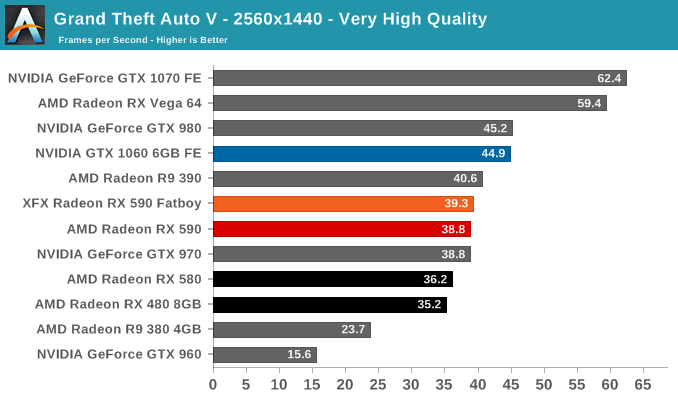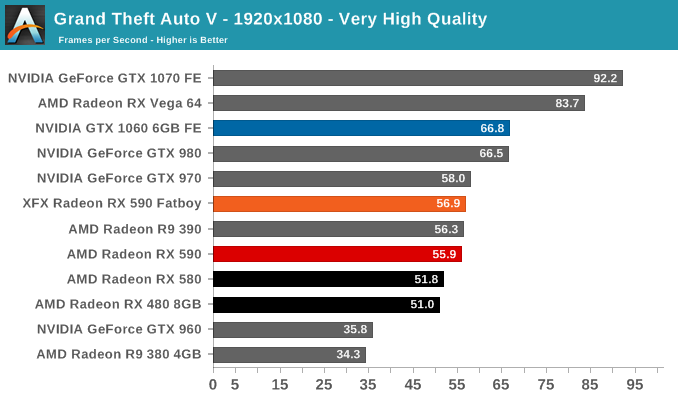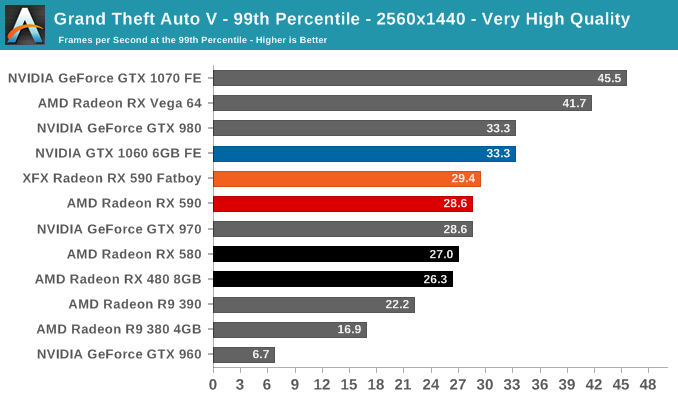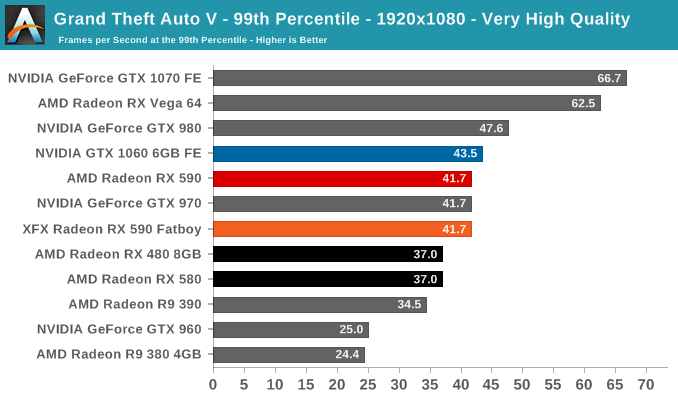The AMD Radeon RX 590 Review, feat. XFX & PowerColor: Polaris Returns (Again)
by Nate Oh on November 15, 2018 9:00 AM ESTGrand Theft Auto V (DX11)
Now a truly venerable title, GTA V is a veteran of past game suites that is still graphically demanding as they come. As an older DX11 title, it provides a glimpse into the graphically intensive games of yesteryear that don't incorporate the latest features. Originally released for consoles in 2013, the PC port came with a slew of graphical enhancements and options. Just as importantly, GTA V includes a rather intensive and informative built-in benchmark, somewhat uncommon in open-world games.
The settings are identical to its previous appearances, which are custom as GTA V does not have presets. To recap, a "Very High" quality is used, where all primary graphics settings turned up to their highest setting, except grass, which is at its own very high setting. Meanwhile 4x MSAA is enabled for direct views and reflections. This setting also involves turning on some of the advanced rendering features - the game's long shadows, high resolution shadows, and high definition flight streaming - but not increasing the view distance any further.


The ever-popular GTA V has proven itself a very demanding game even on the latest hardware, despite its age. Overall NVIDIA cards usually fare much better on it, and the GTX 1060 6GB is no exception. Polaris' best efforts across generations have narrowed the gap but isn't enough to bring it into contention against the GTX 1060 6GB. The 2GB framebuffer of the GTX 960 isn't sufficient for 1440p and falls behind the R9 380 4GB with completely unplayable performance, though at 1440p both the R9 380 4GB and the GTX 960 lack the raw horsepower to drive gameplay at that resolution anyway.













136 Comments
View All Comments
Opencg - Thursday, November 15, 2018 - link
Its just a gap filler. It will help them make money from people wanting to get good performance at that price but... we're still waiting for the serious contenders. Vega refresh will be a little more toward the high end but... navi is where amd could potentially shift the market. RTX means you pay more for less performance outside rtx games. Navi is the opposite you pay less and get more. We need navi to function well and I believe amd can do it.neblogai - Thursday, November 15, 2018 - link
Is is not a gap filler. It is only there, because overproduction of P20 needs to be sold out first. Naturally- P30 should be a replacement of P20, at same price, with minimal investment by MAD or partners.eva02langley - Thursday, November 15, 2018 - link
Polaris is selling well, Vega, not so much beside mining. In Canada, the price are still having a huge price tag because the supply is just so low.Allan_Hundeboll - Thursday, November 15, 2018 - link
I am surprised a boost frequency increase of 15% nets 12% overall performance. Maybe Polaris isn't as starved for memory bandwidth, as people seem to think. Or AMD made other improvements besides the increased frequency...?mapesdhs - Thursday, November 15, 2018 - link
Frequency increases rarely produce linear performance gains, not when there are so many other aspects of a system that impact what's happening (main CPU, API, game engine, etc.)Allan_Hundeboll - Thursday, November 15, 2018 - link
Yes that is why I'm surprised 15% increase on the core frequency -without any increase of the Vram frequency, would result in 12% overall performance increase. Especially considering the "original Polaris" rx480 was configured with 1266Mhz core boost frequency and 2000Mhz Vram.If AMD figured 1266/2000MHz was near the sweet spot balance between core/mem speed then 1545/2000 would be severly starved for memory bandwidth.
So I'm wondering if 2000MHz memory speed was kind of wasted on the rx480? Or did AMD tighten the Vram timings on this new 590? Or maybe the near linear increase in performance is due to the higher tdp allowing the rx590 to sustain the boost clock while the 480 would throttle to base core frequency of 1120MHz?
SlowSpyder - Thursday, November 15, 2018 - link
Where is 7nm Vega??mapesdhs - Thursday, November 15, 2018 - link
Never going to happen, because gamers won't buy it.https://www.youtube.com/watch?v=guK2XoFbPFw
https://www.youtube.com/watch?v=USMlET3L7mA
Cyborg997 - Thursday, November 15, 2018 - link
Summer 2019 or late 2019. Definitely soon rtx fighter.schujj07 - Thursday, November 15, 2018 - link
The most surprising thing to me is just how good RX480 is when you look at the benchmarks. When it launched it was as fast as the GTX970, now it is faster than then GTX980 just due to drivers and newer games being able to use its resources better.